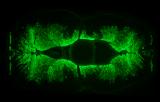I have often challenged students to recognize that our designations of Physics, Chemistry, Biology, Geology, etc. are categories that simply enable us to more easily understand the world around us. Nature knows no such boundaries.
 |
| Mojave Desert tortoise. Photo by Michael Tuma. |
Today's Sci-light also crosses boundaries. Perhaps the picture of a Mojave Desert tortoise doesn't inspire you to imagine boundary crossing, but the story behind the picture should help you get there. The natural habitat for this Tortoise is not limited to the California Mojave; it spans into Utah, Arizona and Nevada interacting with humans, business, as well as other desert dwellers. Michael Tuma, USC Dornsife graduate student in Integrative and Evolutionary Biology, is trying to understand the behavior of this species who can withstand as little as 2 inches of rain a year and temperatures greater than 140 degrees Fahrenheit. (You did notice how integrated his field of study was, right?)
So far, this story sounds like a scientific investigation. How do animals live and survive in extreme environments. But here is where the story shifts. In
Emerging From Their Shells, Amber Dance writer for USC Dornsife explains that it is not only the natural environment that this tortoise must adapt to. In fact, it is the impact of humans in their environment. As businesses like BrightSource Energy, Inc, a solar energy company, move into the desert to build a solar plant, the tortoise faces loss of habitat. And people live in the desert, too, creating roads, homes, and trash that attracts the tortoise's predators. This is why Michael works with SWCA Environmental Consultants in Pasadena, California to help clients minimize harm.
Michael's work is not just done in the field. He primarily uses a computer model. Curious about how? Read the full article and find some great Tortoise Tidbits at the end.
Let's review. We've touched on biology, evolution, business, environment, sociology, and computer science. In my opinion, the Mojave Desert tortoise has crossed many boundaries!




















